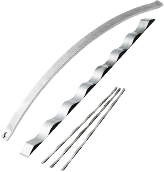Question Spring Newbie 2003/10/8(Wed) 15:15
I am thinking of designing a spring with a spring constant of about k = 160N/mm. Because the value of the spring constant is large, I chose a rectangular wire helical spring, but I don’t know how to measure the wire diameter.
Also, are there any differences from this kind of springs to normal compression coil springs rather than the wire diameter value?
In addition, is it possible to design a spring with an outer diameter of 30 mm or less, an inner diameter of 15 mm or more, a free length of 50 mm, and a required load of 2400 N (specified height 35 mm)? Regardless of the value of the spring constant, the required load is 2400N.
Thank you in advance for your answer.
Answer Tokai Spring 2003/10/10(Fri) 19:29
First of all, the calculation formulas for compression springs and rectangular wire helical springs are different. In addition, the rectangular wire helical spring’s wire thickness x width is equivalent to the compression spring’s wire diameter.
The advantages and disadvantages of rectangular wire helical springs are:
[Advantages]
■ A relatively large spring constant can be obtained in a small space.
[Disadvantages]
■ Energy absorption efficiency is lower than the circular cross-section compression springs
■ The cross-section material must be trapezoidal before coiling, making it a non-versatile material.
■ It is necessary to coil while suppressing the twist of the material, and this makes coiling processing difficult.
Regarding your request at the end of your question, we will contact you by e-mail separately!
We are happy to answer any inquiries regarding technology, specifications, materials, etc. Please feel free to ask.

















